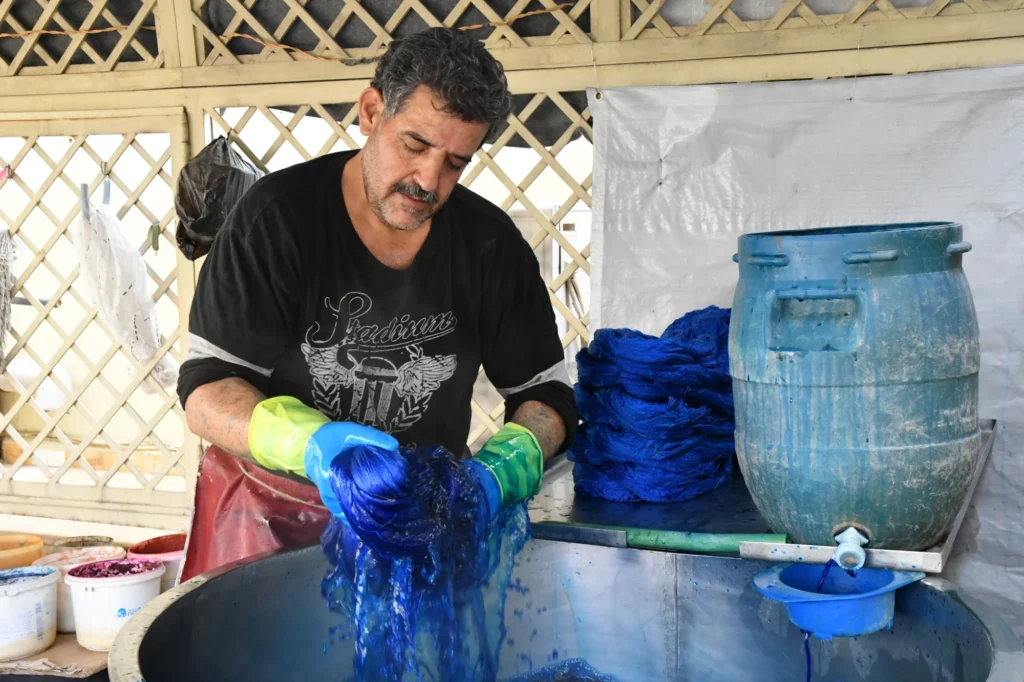by Rania Kataf
For hundreds of years, travelers who journeyed the routes of the Silk Road that passed through Syria came back with the most sensational stories of broad-shouldered men making dye and using it to colour silk and fabric on the rooftops of their houses or khans. Silk dyeing, today a fading craft, used to be one of the most popular skills of the craftsmen of Damascus; the foundations on which the textile craftsmen of the city produced the worldwide fabric known as Damascene Brocade.
But has that become history? The first question that came to my mind when I met Mohamad Rihawi, the last silk dyer in Damascus, was: “What would happen to the craft of silk dying and silk making if for any reason you stop dying silk?” After some hesitation, he answers in a cracking voice: “I tried to teach the secret of this craft to my son, but if you want to dye silk using your bare hands, you have to feel and understand the silk and the dye. This cannot be taught. You cannot teach someone how to love and feel passionate about the material they are working with. I consider myself madly in love with this art, which also needs a lot of patience and strength; it is engraved in every bit of my brain and soul”.
Draykish, a town between the holy city of Tartous and the city of Homs, used to supply the best quality of silk any dyer wishes to work with. As Rihawi describes it, it has a glow to it, more than any other silk he has worked with before, even that of China. Until 2009, silk processed in Draykish was the primary raw material used to produce the famous Damascene Brocade, the traditional hand or machine woven silk with gold or silver threads. Today, with the closure of the silk factory in Draykish, this unique fibre has been substituted by Chinese silk. “And this changed everything,” says Mr. Rihawi, “the dye did not interact the same way with the Chinese silk, it knew it was dealing with a foreign body.”


Introducing the blue dye in boiling water to the silk threads and hanging the dyed silk to dry after washing it in cold water | Rania Kataf (CC-BY-NC-ND)
The Silk Road played a major role in the widespread of silk related crafts and colouring methods in Syria, especially in the city of Damascus. Mohamad Rankous, a brocade craftsman in Damascus is sure that it is due to this role of Damascus that local residents of the city call one of the pigments after the city’s name, al-Azraq al-Shami or “Damascene blue”. He explains that this blue pigment carries a unique relationship with the city’s identity. He says, romanticizing at the sky above us: “For us Damascenes, Damascus is a heaven on earth, a reflection of the true heaven behind this blue sky. This is what made this particular pigment hold this name.”
Feature Image: Florence Ollivry (CC-BY-NC-SA)
Rania Kataf is a Damascus-based visual artist working on documenting the city’s memory through stories and photographs. With her Facebook community group “Humans of Damascus” she tries to engage Damascenes into this process online.

Hello,
thank you very much for your interesting text. I tutor a small project with Syrian children in Lebanon. This year we will study the Ancient Silk Road. We are also planning to visit the city of صور
It would be very nice to get in touch with Mrs. Rania Kataf. Perhaps she or Mr. Rankous would have time to answer a few questions worked out by the students?
Best regards
Caroline Dieluweit
Hello Dear Caroline Dieluweit,
Thank you so much for your interest.
Please email me with your request so we can arrange this together.
Best regards,
Rania